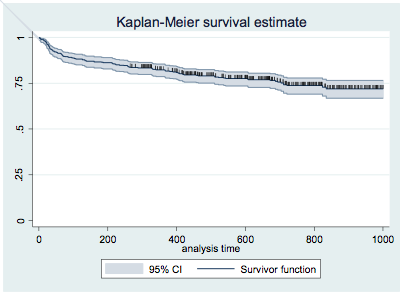Session Information
Date: Tuesday, October 23, 2018
Title: Osteoporosis and Metabolic Bone Disease – Basic and Clinical Science Poster
Session Type: ACR Poster Session C
Session Time: 9:00AM-11:00AM
Background/Purpose:
In Osteoporosis, hip fractures account for significant disease burden, with increased morbi-mortality and financial load on the patient and healthcare system. This study aimed to assess cumulative survival rate of patients with hip fragility fracture aged >= 65 years old, referred to a Rheumatology Department’s Fracture Liaison Service (FLS) after admission to the Orthopaedics Inpatient Care Department, and to determine predictors of mortality.
Methods:
Longitudinal retrospective study of patients referred to a Rheumatology Departmenrt’s FLS from March 2015 until March 2017. Demographic and clinical data were collected. Statistical analysis was performed with STATA. Survival cumulative probabilities were calculated through Kaplan-Meyer curves and hazard ratios (HR) through cox regression, adjusted to age/degree of care dependency.
Results:
522 patients were referred to the FLS, 79.7% female, with median age of 84 years old (65-103). Table 1 summarizes clinical and demographic characteristics. One hundred and nineteen patients (22.8%) died, 36 still during inpatient care. The cumulative survival probability (image 1) at 1, 3, 6, 12 and 24 months was 94.1% (95%CI 91.7-95.9), 91.1% (95%CI 88.2-93.3), 86,3% (95%CI 82.9-89.0%), 81.7 (95%CI 77.9-84.8) and 73.8% (95%CI 69.2-77.8) respectively. Patients >=80 years old presented lower survival rate (HR 1.64, p=0.02), as well as partially dependent and totally dependent patients (HR 1.93, p=0.047; HR 5.3, p=0.000, respectively). Higher femur BMD (HR 0.01, p=0.023) and T-score (HR 0.67, p=0.038) were predictors of better survival outcome. Considering laboratory measurements, higher beta-crosslaps serum values predicted worse survival outcome (HR 4.27, p=0.007). Gender, fracture classification, type of surgical intervention, presence of vertebral fractures, BMI, serum vitamin D and osteocalcin didn’t have impact on survival.
Conclusion:
Knowledge of mortality predictors in hip fracture is essential to optimize survival in these patients. In our study, age, autonomy degree, femur BMD/T-score and beta-crosslaps had impact on survival outcome.
Table 1 – Clinical and demographic characteristics of sample
|
Total (N) |
522 |
|
Age at admission, y (median, min-max) |
84 (65-103) |
|
Sex, female (n, %) |
416, 79.7 |
|
Deaths (n, %) During inpatient care (n, %) |
119, 22.8 36, 6.9 |
|
BMI (N) Underweight (n, %) Normal (n, %) Overweight (n, %) Obesity class I (n, %) |
218 80, 36.7 117, 53.7 20, 9.2 1, 0.5 |
|
Degree of care dependency (N) Totally dependent (n,%) Partially dependent (n,%) Autonomous (n,%) |
307 23, 7.5 78, 25.4 206, 67.1 |
|
Type of fracture Transtrochanteric (n,%) Femoral neck (n,%) Subtrochanteric (n,%) |
262, 50.2 221, 42.3 38, 7.3 |
|
Subsequent fracture (n,%) |
47, 9.0% |
|
Vertebral fracture (N) 0 (n,%) 1 fracture (n,%) >= 2 fractures (n,%) |
236 100, 42.4 56, 25.9 80, 33.9 |
|
Femur BMD, g/cm2 (median, min-max, N) |
0.70, 0.36-1.18, 214 |
|
Femur T score (median, min-max, N) >2.5 (n,%) <=2.5 (n,%) |
-2.6, -7.0-0.7, 214 87, 40.7 127, 59.3 |
|
Intervention (N) Conservative (n,%) Osteosynthesis (n,%) Hemiarthroplasty (n,%) Total arthroplasty (n,%) Girdlestone (n,%) |
516 11, 2.1 337, 65.3 87, 16.9 80, 15.5 1, 0.2 |
|
25(OH)D, ng/ml (median, min-max, N) |
23, 3-54, 219 |
|
OC ng/ml (median, min-max, N) |
28.2, 6.80-198.60, 215 |
|
Beta-crosslaps (median, min-max, N) |
0.71, 0.12-3.28, 217 |
Image 1 – Cumulative survival probability of study sample
To cite this abstract in AMA style:
Guerra M, Ganhão S, Aguiar F, Terroso G, Vieira R, Gonçalves D, Meirinhos T, Martins-Rocha T, Águeda A, Ferreira R, Bernardes M, Vaz C, Lucas R, Costa L. Predictors of Mortality in Patients with Hip Fragility Fracture [abstract]. Arthritis Rheumatol. 2018; 70 (suppl 9). https://acrabstracts.org/abstract/predictors-of-mortality-in-patients-with-hip-fragility-fracture/. Accessed .« Back to 2018 ACR/ARHP Annual Meeting
ACR Meeting Abstracts - https://acrabstracts.org/abstract/predictors-of-mortality-in-patients-with-hip-fragility-fracture/

